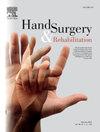Nerve transfer of the median flexor pollicis brevis branch to the deep branch of the ulnar nerve for ulnar nerve palsy: a cadaveric feasibility study
IF 0.9
4区 医学
Q4 ORTHOPEDICS
引用次数: 0
Abstract
An ulnar nerve (UN) palsy is devastating for hand function, resulting in an intrinsic minus position or claw hand with a loss of pinch grip. Distal nerve transfers facilitate faster reinnervation of hand intrinsic muscles in cases of proximal ulnar nerve lesions. The traditional anterior interosseous nerve (AIN) to UN motor transfer is commonly used, however, this still leads to long reinnervation times for the distal intrinsic muscles, important for the thumb to index pinch grip. This study investigated the feasibility of a more distal nerve transfer, from the median thenar to the deep branch of the UN (DBUN), in six cadaveric hands. A separate branch of the median nerve to the superficial head of flexor pollicis brevis (sFPB) arose distally of the thenar branch from the common digital nerve of the thumb shortly before the bifurcation of the ulnar palmar digital nerve to the thumb in all specimens, with a mean distance to the thenar branch of 8.3 ± 5.3 mm. The sFPB motor branch had a mean length of 11.5 ± 1.5 mm. The mean distance between the division of the dorsal cutaneous branch of the UN, where the AIN to UN motor transfer is usually performed, and the transfer between the sFPB branch to the DBUN was 132 ± 11 mm. A distal nerve transfer between the median innervated motor branch to the sFPB to the DBUN shortens the reinnervation distance for the first dorsal interosseous, the adductor pollicis, and the deep head of the FPB muscles, which is a prerequisite for restoration of the pinch grip.
尺神经麻痹的尺神经正中屈肌支与尺神经深支的神经转移:一项尸体可行性研究。
尺神经麻痹对手部功能是毁灭性的,导致固有的负位或爪状手失去捏握。在近端尺神经病变的情况下,远端神经转移有助于手部固有肌肉更快的再神经支配。传统的前骨间神经(AIN)到UN运动转移是常用的,然而,这仍然导致远端固有肌肉的神经移植时间较长,这对于拇指索引捏握很重要。本研究探讨了从大鱼际正中到UN深支(DBUN)的远端神经移植的可行性。所有标本在尺掌指神经分叉前不久,从拇指指总神经远端出现一条通往拇短屈肌浅头(sFPB)的正中神经分支,平均距离为8.3±5.3 mm。sFPB运动支平均长度为11.5±1.5 mm。UN背侧皮支(通常进行AIN到UN的运动转移)与sFPB分支到DBUN的转移之间的平均距离为132±11 mm。中间神经支配运动支到sFPB和DBUN之间的远端神经转移缩短了第一背骨间肌、拇内收肌和FPB肌肉深头的再神经支配距离,这是恢复捏握力的先决条件。
本文章由计算机程序翻译,如有差异,请以英文原文为准。
求助全文
约1分钟内获得全文
求助全文
来源期刊

Hand Surgery & Rehabilitation
Medicine-Surgery
CiteScore
1.70
自引率
27.30%
发文量
0
审稿时长
49 days
期刊介绍:
As the official publication of the French, Belgian and Swiss Societies for Surgery of the Hand, as well as of the French Society of Rehabilitation of the Hand & Upper Limb, ''Hand Surgery and Rehabilitation'' - formerly named "Chirurgie de la Main" - publishes original articles, literature reviews, technical notes, and clinical cases. It is indexed in the main international databases (including Medline). Initially a platform for French-speaking hand surgeons, the journal will now publish its articles in English to disseminate its author''s scientific findings more widely. The journal also includes a biannual supplement in French, the monograph of the French Society for Surgery of the Hand, where comprehensive reviews in the fields of hand, peripheral nerve and upper limb surgery are presented.
Organe officiel de la Société française de chirurgie de la main, de la Société française de Rééducation de la main (SFRM-GEMMSOR), de la Société suisse de chirurgie de la main et du Belgian Hand Group, indexée dans les grandes bases de données internationales (Medline, Embase, Pascal, Scopus), Hand Surgery and Rehabilitation - anciennement titrée Chirurgie de la main - publie des articles originaux, des revues de la littérature, des notes techniques, des cas clinique. Initialement plateforme d''expression francophone de la spécialité, la revue s''oriente désormais vers l''anglais pour devenir une référence scientifique et de formation de la spécialité en France et en Europe. Avec 6 publications en anglais par an, la revue comprend également un supplément biannuel, la monographie du GEM, où sont présentées en français, des mises au point complètes dans les domaines de la chirurgie de la main, des nerfs périphériques et du membre supérieur.
 求助内容:
求助内容: 应助结果提醒方式:
应助结果提醒方式:


